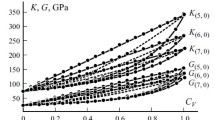Abstract
A new model is put forward to bound the effective elastic moduli of composites with ellipsoidal inclusions. In the present paper, transition layer for each ellipsoidal inclusion is introduced to make the trial displacement field for the upper bound and the trial stress field for the lower bound satisfy the continuous interface conditions which are absolutely necessary for the application of variational principles. According to the principles of minimum potential energy and minimum complementary energy, the upper and lower bounds on the effective elastic moduli of composites with ellipsoidal inclusions are rigorously derived. The effects of the distribution and geometric parameters of ellipsoidal inclusions on the bounds of the effective elastic moduli are analyzed in details. The present upper and lower bounds are still finite when the bulk and shear moduli of ellipsoidal inclusions tend to infinity and zero, respectively. It should be mentioned that the present method is simple and needs not calculate the complex integrals of multi-point correlation functions. Meanwhile, the present paper provides an entirely different way to bound the effective elastic moduli of composites with ellipsoidal inclusions, which can be developed to obtain a series of bounds by taking different trial displacement and stress fields.
Similar content being viewed by others
References
Hashin, Z.: Analysis of composite materials-A Survey. ASME Journal of Applied Mechanics 55, 481–505 (1983)
Torquato, S.: Random heterogeneous media: Microstructure and improved bounds on effective properties. Applied Mechanics Review 44(2), 37–76 (1991)
Nemat-Nasser, S., Hori, M.: Micromechanics: Overall Properties of Heterogeneous Materials. Horth-Holland, Amsterdam (1993)
Milton, G. W.: The Theory of Composites. Cambridge University Press, Cambridge, UK (2002)
Torquato, S.: Random Heterogeneous Materials: Microstructure and Macroscopic Properties. Springer, New York (2002)
Voigt, W.: Lehrbuch der Kristallphysik. Teubner, Berlin (1910) (in German)
Reuss, A.: Berechnung der fliessgrense von mischkristallen auf grund der plastizitätsbedingung für einkristalle. Zeitschrift fur Angewandte Mathematik und Mechanik. 9, 49–58 (1929) (in German)
Hashin, Z., Shtrikman, S.: On some variational principles in anisotropic and nonhomogeneous elasticity. Journal of the Mechanics and Physics of Solids 10, 335–342 (1962)
Hashin, Z., Shtrikman, S.: A variational approach to the theory of the elastic behaviour of multiphase materials. Journal of the Mechanics and Physics of Solids 11, 127–140 (1963)
Walpole, L. J.: On bounds for the overall elastic moduli of inhomogeneous systems-I. Journal of the Mechanics and Physics of Solids 14, 151–162 (1966)
Hill, R.: New derivations of some elastic extremum principles, in Progress in Applied Mechanics. Prager Aniversary Volume, Macmillan, New York, 91–106 (1963)
Willis, J. R.: Bounds and self-consistent estimates for the overall moduli of anisotropic composites. Journal of the Mechanics and Physics of Solids 25, 185–202 (1977)
Willis, J. R.: Variational principles and bounds for the overall properties of composites. In: Continuum Models for Discrete Systems, Provan J.W. ed. University of Waterloo Press, Waterloo, 185–215 (1978)
Ponte Castaneda, P., Willis, J. R.: The effect of spatial distribution on the effective behavior of composite materials and cracked media. Journal of the Mechanics and Physics of Solids 43, 1919–1951 (1995)
Monetto, I., Drugan, W. J.: A micromechanics-based nonlocal constitutive equation for elastic composites containing randomly oriented spheroidal heterogeneities. Journal of the Mechanics and Physics of Solids 52, 359–393 (2004)
Kröner, E.: Bounds for effective elastic moduli of disordered materials. Journal of the Mechanics and Physics of Solids 25, 137–155 (1977)
Milton, G. W., Kohn, R.: Variational bounds on the effective properties of anisotropic composites. Journal of the Mechanics and Physics of Solids 36, 597–629 (1988)
Beran, M. J., Molyneux J.: Use of classical variational principles to determine bounds for the effective bulk modulus in heterogeneous media. Quarterly of Applied Mathematics 24, 107–118 (1966)
McCoy, J. J.: Recent Advances in Engineering Science, Vol.5. Gordon and Breach, New York (1970)
Milton, G. W., Phan-Thien, N.: New bounds on the effective moduli of two component materials. Proceedings of the Royal Society of London A 380, 305–331 (1982)
Torquato, S.: Effective stiffness tensor of composite media: II. Applications to isotropic dispersions. Journal of the Mechanics and Physics of Solids 46, 1411–1440 (1998)
Berryman, J. G.: Measures of microstructure to improve estimates and bounds on elastic constants and transport coefficients in heterogeneous media. Mechanics of Materials 38, 732–747 (2006)
Keller, J. B., Rubenfeld, L. A., Molyneux, J. E.: Extremum principles for slow viscous flows with applications to suspensions. Journal of Fluid Mechanics 30, 97–125 (1967)
Horn, R. A., Johnson, C. R.: Topics in Matrix Analysis. Cambridge University Press, England (1991)
Hashin, Z.: On elastic behaviour of fiber reinforced materials of arbitrary transverse phase geometry. Journal of the Mechanics and Physics of Solids 13, 119–134 (1965)
Hashin, Z.: The elastic moduli of heterogeneous materials. ASME Journal of Applied Mechanics 29, 143–150 (1962)
Wu, L. Z.: Bounds on the effective elastic moduli of composites with spherical inclusions, In: Advances in Solid Mechanics, in Honor of Professor D. Wang’s 90th Anniversary, Harbin Institute of Technology Press, Harbin, 112–121 (2010) (in Chinese)
Author information
Authors and Affiliations
Corresponding author
Additional information
The project was supported by the National Natural Science Foundation of China (11072068 and 11002041).
Rights and permissions
About this article
Cite this article
Wu, LZ., Pan, SD. Bounds on the overall properties of composites with ellipsoidal inclusions. Acta Mech Sin 28, 1340–1355 (2012). https://doi.org/10.1007/s10409-012-0102-y
Received:
Revised:
Accepted:
Published:
Issue Date:
DOI: https://doi.org/10.1007/s10409-012-0102-y




